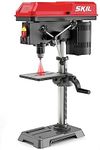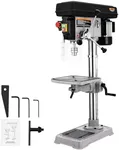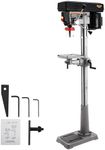Buying Guide for the Best Benchtop Drill Presses
Choosing the right benchtop drill press can make a significant difference in the quality and efficiency of your work. A benchtop drill press is a versatile tool that can handle a variety of drilling tasks with precision and ease. When selecting a benchtop drill press, it's important to consider several key specifications to ensure you get the best fit for your needs. Understanding these specs will help you make an informed decision and choose a drill press that meets your specific requirements.Drill Press SizeThe size of a drill press is typically measured by the 'swing,' which is the distance from the center of the spindle to the closest edge of the column, multiplied by two. This measurement determines the maximum width of material you can drill through the center. For light to medium tasks, a smaller swing (8-10 inches) is sufficient. For larger projects, consider a drill press with a swing of 12 inches or more. Choose a size that matches the scale of your typical projects.
Motor PowerMotor power is measured in horsepower (HP) and determines the drill press's ability to handle tough materials and larger bits. For most DIY and light industrial tasks, a motor with 1/3 to 1/2 HP is adequate. For more demanding tasks, such as drilling through metal or hardwood, a motor with 3/4 HP or more is recommended. Assess the materials you will be working with to determine the appropriate motor power for your needs.
Speed SettingsSpeed settings refer to the number of revolutions per minute (RPM) the drill press can achieve. Variable speed settings allow you to adjust the RPM to match the material and bit size, providing better control and precision. For general use, a drill press with 5-12 speed settings is sufficient. If you work with a variety of materials, look for a model with a wider range of speeds. Consider the types of projects you will be undertaking to choose the right speed range.
Table Size and AdjustabilityThe table size and its adjustability are crucial for supporting your workpiece and ensuring accurate drilling. A larger table provides more support for bigger projects, while an adjustable table allows you to tilt and rotate it for angled drilling. For most users, a table size of around 8x8 inches is adequate. If you frequently work on larger or more complex projects, look for a drill press with a larger and more adjustable table. Think about the size and type of materials you will be drilling to determine the best table size and adjustability.
Depth StopA depth stop is a feature that allows you to set a specific drilling depth, ensuring consistent and precise holes. This is particularly useful for repetitive tasks where uniform depth is critical. For general use, a simple depth stop mechanism is sufficient. For more precise work, look for a drill press with a more advanced depth stop system. Consider the importance of consistent hole depth in your projects to decide on the right depth stop feature.
Chuck SizeThe chuck size determines the maximum diameter of the drill bit that the drill press can accommodate. Common chuck sizes are 1/2 inch and 5/8 inch. For most DIY and light industrial tasks, a 1/2 inch chuck is sufficient. If you need to use larger bits for more demanding projects, consider a drill press with a 5/8 inch chuck. Evaluate the types of drill bits you will be using to choose the appropriate chuck size.





















